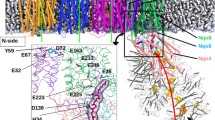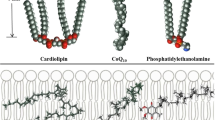Abstract
In this review, we discuss the mechanisms of generation of membrane-bound protons using different energy sources in model and natural systems. Analysis of these mechanisms revealed that all three types of reactions include the same principal stage, which is dissociation of electrically neutral Brønsted acids at the interface during transition from the hydrophobic phase to water with a low dielectric constant. Special attention is paid to the fact that in one of the analyzed model systems, membrane-bound protons provide energy for the reaction of ATP synthesis. Similar mechanism for the generation of membrane-bound protons has been found in natural membranes involved in oxidative phosphorylation, in particular, on the membranes of mitoplasts and mitochondria. The energy of oxidative reactions required for ATP synthesis, is stored at the intermediate stage not only in the form of transmembrane electrochemical potential of protons, but also and perhaps mostly, as protons attached to the inner mitochondrial membrane. The process of energy storage in mitochondria is linked to the transfer of protons that simultaneously perform two functions. Protons on the membrane surface carry free energy and, at the same time, act as substrates facilitating the movement of F1F0-ATP-synthase biological machine.







Similar content being viewed by others
Abbreviations
- BLM:
-
bilayer lipid membrane
- OXPHOS:
-
oxidative phosphorylation
References
Mitchell, P. (1961) Coupling of phosphorylation to electron and hydrogen transfer by a chemi-osmotic type of mechanism, Nature, 191, 144-148.
Skulachev, V. P., Sharaf, A. A., and Liberman, E. A. (1967) Proton conductors in the respirator chain and artificial membranes, Nature, 216, 718-719, https://doi.org/10.1038/216718a0.
Liberman, E. A., Topaly, V. P., Tsofina, L. M., Jasaitis, A. A., and Skulachev, V. P. (1969) Mechanism of coupling of oxidative phosphorylation and the membrane potential of mitochondria, Nature, 222, 1076-1078, https://doi.org/10.1038/2221076a0.
Drachev, L. A., Jasaitis, A. A., Kaulen, A. D., Kondrashin, A. A., Liberman, E. A., et al. (1974) Direct measurement of electric current generation by cytochrome oxidase, H+-ATPase and bacteriorhodopsin, Nature, 249, 321-324, https://doi.org/10.1038/249321a0.
Williams, R. J. P. (1961) Possible functions of chains of catalysts, J. Theor. Biol., 1, 1-17, https://doi.org/10.1016/0022-5193(61)90023-6.
Kell, D. B. (1979) On the functional proton current pathway of electron transport phosphorylation: An electrodic view, Biochim. Biophys. Acta, 9, 55-99, https://doi.org/10.1016/0304-4173(79)90018-1.
Mitchell, P. (1991) Foundations of vectorial metabolism and osmochemistry, Biosci. Rep., 11, 297-346, https://doi.org/10.1007/BF01130212.
Junge, W., and Ausländer, W. (1974) The electric generator in photosynthesis of green plants. I. Vectorial and protolytic properties of the electron transport chain, Biochim. Biophys. Acta Bioenerg., 333, 59-70, https://doi.org/10.1016/0005-2728(74)90163-7.
Drachev, L. A., Kaulen, A. D., and Skulachev, V. P. (1984) Correlation of photochemical cycle, H+ release and uptake, and electric events in bacteriorhodopsin, FEBS Lett., 178, 331-335, https://doi.org/10.1016/0014-5793(84)80628-6.
Yaguzhinsky, L. S., Boguslavsky, L. I., Volkov, A. G., and Rakhmaninova, A. B. (1976) Synthesis of ATP coupled with action of membrane protonic pumps at the octane–water interface, Nature, 259, 494-496, https://doi.org/10.1038/259494a0.
Heberle, J., Riesle, J., Thiedemann, G., Oesterhelt, D., and Dencher, N. A. (1994) Proton migration along the membrane surface and retarded surface to bulk transfer, Nature, 370, 379-382, https://doi.org/10.1038/370379a0.
Alexiev, U., Mollaaghababa, R., Scherrer, P., Khorana, H. G., and Heyn, M. P. (1995) Rapid long-range proton diffusion along the surface of the purple membrane and delayed proton transfer into the bulk, Proc. Natl. Acad. Sci. USA, 92, 372-376.
Gopta, O. A., Cherepanov, D. A., Junge, W., and Mulkidjanian, A. Y. (1999) Proton transfer from the bulk to the bound ubiquinone QB of the reaction center in chromatophores of Rhodobacter sphaeroides: Retarded conveyance by neutral water, Proc. Natl. Acad. Sci. USA, 96, 13159-13164, https://doi.org/10.1073/pnas.96.23.13159.
Cherepanov, D. A., Junge, W., and Mulkidjanian, A. Y. (2004) Proton transfer dynamics at the membrane/water interface: dependence on the fixed and mobile pH buffers, on the size and form of membrane particles, and on the interfacial potential barrier, Biophys. J., 86, 665-680, https://doi.org/10.1016/S0006-3495(04)74146-6.
Medvedev, E., and Stuchebrukhov, A. (2012) Mechanism of long-range proton translocation along biological membranes, FEBS Lett., 587, 345-349, https://doi.org/10.1016/j.febslet.2012.12.010.
Weichselbaum, E., Österbauer, M., Knyazev, D. G., Batishchev, O. V., Akimov, S. A., et al. (2017) Origin of proton affinity to membrane/water interfaces, Sci. Rep., 7, 4553, https://doi.org/10.1038/s41598-017-04675-9.
Toth, A., Meyrat, A., Stoldt, S., Santiago, R., Wenzel, D., et al. (2020) Kinetic coupling of the respiratory chain with ATP synthase, but not proton gradients, drives ATP production in cristae membranes, Proc. Natl. Acad. Sci. USA, 117, 2412-2421, https://doi.org/10.1073/pnas.1917968117.
Sjöholm, J., Bergstrand, J., Nilsson, T., Šachl, R., Ballmoos, C., et al. (2017) The lateral distance between a proton pump and ATP synthase determines the ATP-synthesis rate, Sci. Rep., 7, 1-12, https://doi.org/10.1038/s41598-017-02836-4.
Nesterov, S., Chesnokov, Y., Kamyshinsky, R., Panteleeva, A., Lyamzaev, K., et al. (2021) Ordered clusters of the complete oxidative phosphorylation system in cardiac mitochondria, Int. J. Mol. Sci., 22, 1462, https://doi.org/10.3390/ijms22031462.
Morelli, A. M., Ravera, S., Calzia, D., and Panfoli, I. (2019) An update of the chemiosmotic theory as suggested by possible proton currents inside the coupling membrane, Open Biol., 9, https://doi.org/10.1098/rsob.180221.
Lee, J. W. (2021) Mitochondrial energetics with transmembrane electrostatically localized protons: do we have a thermotrophic feature? Sci. Rep., 11, 14575, https://doi.org/10.1038/s41598-021-93853-x.
Teschke, O., Ceotto, G., and de Souza, E. F. (2001) Interfacial water dielectric-permittivity-profile measurements using atomic force microscopy, Phys. Rev. E, 64, 011605, https://doi.org/10.1103/PhysRevE.64.011605.
Tashkin, V. Yu., Vishnyakova, V. E., Shcherbakov, A. A., Finogenova, O. A., Ermakov, Yu. A., et al. (2019) Changes in the capacitance and boundary potential of a bilayer lipid membrane associated with a fast release of protons on its surface, Biochemistry (Moscow) Suppl. A Membr. Cell Biol., 13, 101-108, https://doi.org/10.1134/S1990747819020077.
Moiseeva, V. S., Motovilov, K. A., Lobysheva, N. V., Orlov, V. N., and Yaguzhinsky, L. S. (2011) The formation of metastable bond between protons and mitoplast surface, Dokl. Biochem. Biophys., 438, 127-130.
Eroshenko, L. V., Marakhovskaya, A. S., Vangeli, I. M., Semenyuk, P. I., Orlov, V. N., et al. (2012) Bronsted acids bounded to the mitochondrial membranes as a substrate for ATP synthase, Dokl. Biochem. Biophys., 444, 158-161.
Ermakov, Y. A., and Nesterenko, A. M. (2017) Boundary potential of lipid bilayers: Methods and interpretations, J. Phys. Conf. Ser., 780, 012002, https://doi.org/10.1088/1742-6596/780/1/012002.
Antonenko, Y. N., Kovbasnjuk, O. N., and Yaguzhinsky, L. S. (1993) Evidence in favor of the existence of a kinetic barrier for proton transfer from a surface of bilayer phospholipid membrane to bulk water, Biochim. Biophys. Acta, 1150, 45-50, https://doi.org/10.1016/0005-2736(93)90119-K.
Gonella, G., Backus, E. H. G., Nagata, Y., Bonthuis, D. J., Loche, P., et al. (2021) Water at charged interfaces, Nat. Rev. Chem., 5, 466-485, https://doi.org/10.1038/s41570-021-00293-2.
Antonenko, Yu. N., and Yaguzhinsky, L. S. (1982) Generation of potential in lipid bilayer membranes as a result of proton-transfer reactions in the unstirred layers, J. Bioenerg. Biomembr., 14, 457-465, https://doi.org/10.1007/BF00743071.
Antonenko, Y. N., and Yaguzhinsky, L. S. (1990) Effect of changes in cation concentration near bilayer lipid membrane on the rate of carrier-mediated cation fluxes and on the carrier apparent selectivity, Biochim. Biophys. Acta, 1026, 236-240, https://doi.org/10.1016/0005-2736(90)90069-Z.
Eremeev, S. A. and Yaguzhinsky, L. S. (2015) On local coupling of electron transport and ATP-synthesis system in mitochondria. Theory and experiment, Biochemistry (Moscow), 80, 576-581, https://doi.org/10.1134/S0006297915050089.
Kovbasnjuk, O. N., Antonenko, Y. N., and Yaguzhinsky, L. S. (1991) Proton dissociation from nigericin at the membrane–water interface, the rate-limiting step of K+/H+ exchange on the bilayer lipid membrane, FEBS Lett., 289, 176-178, https://doi.org/10.1016/0014-5793(91)81063-E.
Evtodienko, V. Y., Antonenko, Y. N., and Yaguzhinsky, L. S. (1998) Increase of local hydrogen ion gradient near bilayer lipid membrane under the conditions of catalysis of proton transfer across the interface, FEBS Lett., 425, 222-224, https://doi.org/10.1016/s0014-5793(98)00233-6.
Dragunova, S. F., Krasinskaya, I. P., and Yaguzhinsky, L. S. (1981) Regulation of proton transfer across the electrical double layer on the mitochondrial membrane, Biokhimiya, 46, 1087-1095.
Geißler, D., Antonenko, Y. N., Schmidt, R., Keller, S., Krylova, O. O., et al. (2005) (Coumarin-4-yl)methyl esters as highly efficient, ultrafast phototriggers for protons and their application to acidifying membrane surfaces, Angew. Chem. Int. Ed., 44, 1195-1198, https://doi.org/10.1002/anie.200461567.
Serowy, S., Saparov, S. M., Antonenko, Y. N., Kozlovsky, W., Hagen, V., et al. (2003) Structural proton diffusion along lipid bilayers, Biophys. J., 84, 1031-1037.
Springer, A., Hagen, V., Cherepanov, D. A., Antonenko, Y. N., and Pohl, P. (2011) Protons migrate along interfacial water without significant contributions from jumps between ionizable groups on the membrane surface, Proc. Natl. Acad. Sci. USA, 108, 14461-14466, https://doi.org/10.1073/pnas.1107476108.
Zaslavsky, D., Sadoski, R. C., Rajagukguk, S., Geren, L., Millett, F., et al. (2004) Direct measurement of proton release by cytochrome c oxidase in solution during the F→O transition, Proc. Natl. Acad. Sci. USA, 101, 10544-10547, https://doi.org/10.1073/pnas.0401521101.
Le Coutre, J., and Gerwert, K. (1996) Kinetic isotope effects reveal an ice-like and a liquid-phase-type intramolecular proton transfer in bacteriorhodopsin, FEBS Lett., 398, 333-336, https://doi.org/10.1016/S0014-5793(96)01254-9.
Salomonsson, L., Brändén, G., and Brzezinski, P. (2008) Deuterium isotope effect of proton pumping in cytochrome c oxidase, Biochim. Biophys. Acta, 1777, 343-350, https://doi.org/10.1016/j.bbabio.2007.09.009.
Salomonsson, L., Faxén, K., Adelroth, P., and Brzezinski, P. (2005) The timing of proton migration in membrane-reconstituted cytochrome c oxidase, Proc. Natl. Acad. Sci. USA, 102, 17624-17629, https://doi.org/10.1073/pnas.0505431102.
Zhang, C., Knyazev, D. G., Vereshaga, Y. A., Ippoliti, E., Nguyen, T. H., et al. (2012) Water at hydrophobic interfaces delays proton surface-to-bulk transfer and provides a pathway for lateral proton diffusion, Proc. Natl. Acad. Sci. USA, 109, 9744-9749, https://doi.org/10.1073/pnas.1121227109.
Yurkov, V. I., Fadeeva, M. S., and Yaguzhinsky, L. S. (2005) Proton transfer through the membrane-water interfaces in uncoupled mitochondria, Biochemistry (Moscow), 70, 195-199, https://doi.org/10.1007/s10541-005-0101-8.
Solodovnikova, I. M., Yurkov, V. I., Tonshin, A. A., and Yaguzhinsky, L. S. (2004) Local coupling between respiration and phosphorylation in rat liver mitochondria, Biophysics, 49, 42-51.
Conway, B. E. (1999) Electrochemical Supercapacitors: Scientific Fundamentals and Technological Applications, Springer Science & Business Media, New York.
Deplazes, E., White, J., Murphy, C., Cranfield, C. G., and Garcia, A. (2019) Competing for the same space: Protons and alkali ions at the interface of phospholipid bilayers, Biophys. Rev., 11, 483-490, https://doi.org/10.1007/s12551-019-00541-2.
Funding
This work was supported by the Russian Foundation for Basic Research (project no. 19-04-00835) and Kurchatov Institute National Research Center (research task “Investigation of generation, transfer, and distribution of energy in live organisms”).
Author information
Authors and Affiliations
Corresponding author
Ethics declarations
The authors declare no conflicts of interest in financial or any other sphere. This article does not contain any studies with human participants or animals performed by any of the authors.
Rights and permissions
About this article
Cite this article
Nesterov, S.V., Smirnova, E.G. & Yaguzhinsky, L.S. Mechanism of Energy Storage and Transformation in the Mitochondria at the Water–Membrane Interface. Biochemistry Moscow 87, 179–190 (2022). https://doi.org/10.1134/S0006297922020092
Received:
Revised:
Accepted:
Published:
Issue Date:
DOI: https://doi.org/10.1134/S0006297922020092




